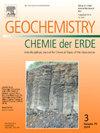多重分形地球化学分析、构造控制与模糊c均值无监督聚类相结合的找矿新框架
IF 2.9
3区 地球科学
Q2 GEOCHEMISTRY & GEOPHYSICS
引用次数: 0
摘要
在矿产勘探中,由于背景重叠和矿化控制各向异性,特别是在构造复杂的地区,如伊朗西北部的Takhte-Soleyman地区,乌鲁木齐-多克塔尔岩浆弧(UDMA)的一部分,探测覆盖区域的弱地球化学异常仍然是一个重大挑战。本研究通过引入一种新的框架来解决这些问题,该框架可以增强金(Au)和铅锌(PbZn)矿床的勘探目标。该方法集成了多重分形地球化学异常分离,包括多重分形逆距离加权(MIDW)、光谱面积(S-A)和局部奇点映射(LSM)模型,以及距离分布分析(DDA)和模糊c均值(FCM)聚类,以解释结构和地球化学的复杂性。因子分析确定了关键元素组合- Au与As和Sb, PbZn与Ag和cd -而DDA圈定了西北(NW)和东北(NE)走向断裂为关键控制,约85%的Au和77%的PbZn矿床位于这些断裂的1公里范围内。该框架通过使用VXB指数优化FCM聚类来细化前景模型,以高潜力区域为目标。结果表明,基于fcm的LSM异常检测效果较好,Au和PbZn的曲线下面积(AUC)分别为94.8%和88.08%,与已知矿床具有较强的空间相关性,为复杂环境下的勘探提供了实用工具。该方法克服了传统方法的局限性,促进了矿产远景填图的发展,在其他成矿省份也有应用前景。本文章由计算机程序翻译,如有差异,请以英文原文为准。
A new framework for exploration targeting: Integrating multifractal geochemical analysis, structural controls and fuzzy C-means unsupervised clustering
In mineral exploration, detecting weak geochemical anomalies in covered areas remains a significant challenge due to overlapping backgrounds and anisotropic mineralization controls, particularly in tectonically complex regions like the Takhte-Soleyman district, northwest Iran, part of the Urumieh-Dokhtar magmatic arc (UDMA). This study addresses these issues by introducing a novel framework that enhances exploration targeting for gold (Au) and lead‑zinc (Pb![]() Zn) deposits. The methodology integrates multifractal geochemical anomaly separation, including multifractal inverse distance weighting (MIDW), spectrum-area (S-A) and local singularity mapping (LSM) models, alongside distance-distribution analysis (DDA) and fuzzy c-means (FCM) clustering, to account for structural and geochemical complexities. Factor analysis identifies key elemental associations—Au with As and Sb, and Pb
Zn) deposits. The methodology integrates multifractal geochemical anomaly separation, including multifractal inverse distance weighting (MIDW), spectrum-area (S-A) and local singularity mapping (LSM) models, alongside distance-distribution analysis (DDA) and fuzzy c-means (FCM) clustering, to account for structural and geochemical complexities. Factor analysis identifies key elemental associations—Au with As and Sb, and Pb![]() Zn with Ag and Cd—while DDA delineates northwest (NW) and northeast (NE) trending faults as critical controls, with approximately 85 % of Au and 77 % of Pb
Zn with Ag and Cd—while DDA delineates northwest (NW) and northeast (NE) trending faults as critical controls, with approximately 85 % of Au and 77 % of Pb![]() Zn deposits located within 1 km of these faults. The framework refines prospectivity models by optimizing FCM clustering with the VXB index, targeting high-potential zones. Results demonstrate FCM-based LSM's superior anomaly detection, achieving area under curve (AUC) values of 94.8 % for Au and 88.08 % for Pb
Zn deposits located within 1 km of these faults. The framework refines prospectivity models by optimizing FCM clustering with the VXB index, targeting high-potential zones. Results demonstrate FCM-based LSM's superior anomaly detection, achieving area under curve (AUC) values of 94.8 % for Au and 88.08 % for Pb![]() Zn, with strong spatial correlations to known deposits, offering a practical tool for exploration in challenging environments. This approach advances mineral prospectivity mapping (MPM) by overcoming limitations of traditional methods, with potential applications to other metallogenic provinces.
Zn, with strong spatial correlations to known deposits, offering a practical tool for exploration in challenging environments. This approach advances mineral prospectivity mapping (MPM) by overcoming limitations of traditional methods, with potential applications to other metallogenic provinces.
求助全文
通过发布文献求助,成功后即可免费获取论文全文。
去求助
来源期刊

Chemie Der Erde-Geochemistry
地学-地球化学与地球物理
CiteScore
7.10
自引率
0.00%
发文量
40
审稿时长
3.0 months
期刊介绍:
GEOCHEMISTRY was founded as Chemie der Erde 1914 in Jena, and, hence, is one of the oldest journals for geochemistry-related topics.
GEOCHEMISTRY (formerly Chemie der Erde / Geochemistry) publishes original research papers, short communications, reviews of selected topics, and high-class invited review articles addressed at broad geosciences audience. Publications dealing with interdisciplinary questions are particularly welcome. Young scientists are especially encouraged to submit their work. Contributions will be published exclusively in English. The journal, through very personalized consultation and its worldwide distribution, offers entry into the world of international scientific communication, and promotes interdisciplinary discussion on chemical problems in a broad spectrum of geosciences.
The following topics are covered by the expertise of the members of the editorial board (see below):
-cosmochemistry, meteoritics-
igneous, metamorphic, and sedimentary petrology-
volcanology-
low & high temperature geochemistry-
experimental - theoretical - field related studies-
mineralogy - crystallography-
environmental geosciences-
archaeometry
 求助内容:
求助内容: 应助结果提醒方式:
应助结果提醒方式:


